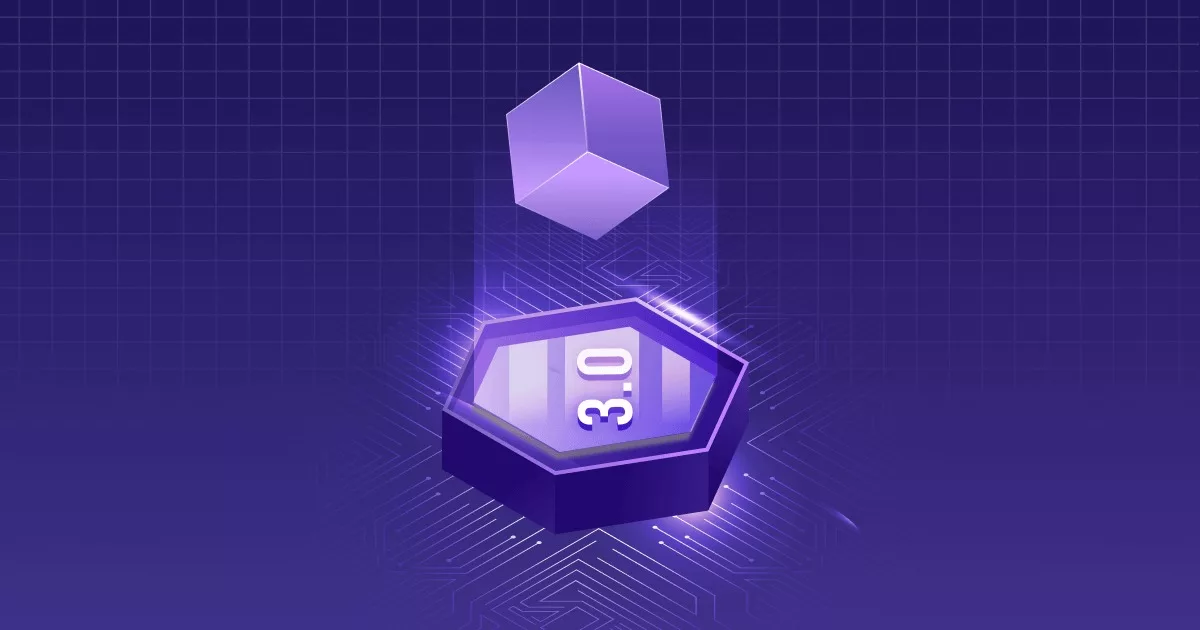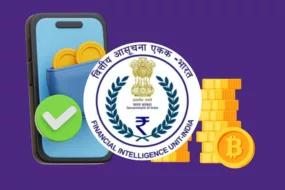
Blockchain technology has come a long way since its inception as the underlying technology behind Bitcoin. It was first introduced in 2008 by a person or group using the pseudonym ‘Satoshi Nakamoto’ in a paper titled ‘Bitcoin: A Peer-to-Peer Electronic Cash System.’ The technology has evolved and advanced each year to become more robust, secure, and versatile. Thus, this evolution has given rise to what is commonly called “Blockchain 3.0.”
Read on as we will delve into the evolution of blockchain technology, explore the improvements that led to Blockchain 3.0, and explain its key features and benefits.
P.S.: Blockchain was initially conceptualized as a decentralized or public network. Then considering its potential, centralized or private blockchains were developed to cater to enterprise-related use cases. But this article will exclusively focus on public blockchains, not private ones.
Defining Blockchain
At its core, blockchain is a decentralized, distributed ledger that records transactions securely and transparently. It’s like a digital version of a traditional ledger book, except that it’s distributed across a network of computers.
Each block in the chain contains a record of several transactions the network has verified. Once a block is added to the chain, it cannot be altered or deleted, making the system immutable. This immutability makes the blockchain very secure because it is tough for hackers to tamper with the data.
How Does a Blockchain Work?
Here’s an example to help illustrate how blockchain works.
So let’s say that you’re buying a car from someone online. Usually, you’d have to go through a middleman, like a bank or a payment processor, to make the transaction. But with blockchain, you can do it directly without needing a middleman.
So, you and the seller agree on a price and send the payment to the seller’s digital wallet using a cryptocurrency like Bitcoin. The transaction is recorded on the blockchain, and everyone on the network can see it happened. The seller can then transfer ownership of the car to you, and that transaction is also recorded on the blockchain.
Because the blockchain is distributed across a network of computers, it’s highly secure. For someone to alter or delete a transaction, they would have to control most of the network’s computing power, which is extremely difficult and expensive.
Another example of how blockchain is being used is in supply chain management. Companies use blockchain to track the movement of goods from one point to another. It ensures all parties can access the same information and reduces the risk of counterfeit goods.
For example, let’s say that a company is importing a shipment of bananas from a farm in South America. Using blockchain, the company can track the bananas from the farm to the port of departure, the shipping container, the port of arrival, and finally, to the store.
Each process step is recorded on the blockchain, and everyone on the network can see that the bananas are authentic and have been handled correctly throughout the supply chain. This helps to ensure that consumers are getting high-quality products, and it also helps to reduce waste and improve efficiency in the supply chain.
Evolution of Blockchain Technology
1. Blockchain 1.0
Blockchain 1.0 refers to the first generation of blockchain technology. It was used to create a decentralized digital currency system, namely Bitcoin.
Blockchain 1.0 is characterized by its ability to create a secure, transparent, and immutable ledger that records all transactions in a decentralized and distributed network. It primarily focused on the exchange of digital currency and was designed to address the issue of double-spending in digital transactions.
The critical feature of Blockchain 1.0 is its use of a proof-of-work (PoW) consensus algorithm, which is used to validate transactions and maintain the ledger’s integrity.
The PoW algorithm requires miners to solve complex mathematical problems to add new transactions to the blockchain. This process ensures that transactions are verified and recorded in a tamper-proof manner.
Scalability and high energy consumption are some of the significant drawbacks of Blockchain 1.0.
For instance, the Bitcoin network can handle a maximum of around seven transactions per second. Moreover, Bitcoin Energy Consumption Index estimated that one Bitcoin transaction takes 1,449 kWh. It is approximately equal to 50 days of power for the average US household.
2. Blockchain 2.0
Blockchain 2.0 generally refers to the evolution of blockchain technology beyond its original use case as a decentralized ledger for cryptocurrencies like Bitcoin.
This next step in the evolution of blockchain tech is associated with smart contract functionality. It helps create decentralized applications (dApps) that perform complex operations without intermediaries.
Smart contracts are self-executing programs that run on the blockchain and can automatically enforce the rules and regulations encoded within them.
Ethereum is often cited as the first major Blockchain 2.0 platform, as it introduced smart contracts and allowed for the developing of a wide range of dApps.
Interoperability was a significant concern around Blockchain 2.0 as different blockchain networks were not compatible with each other. Thus it was challenging to create a truly decentralized and interconnected ecosystem.
3. Blockchain 3.0
Blockchain 3.0 builds on the foundation of earlier generations of blockchain technology but adds new features such as scalability, interoperability, and the ability to support more complex decentralized applications.
It uses directed acyclic graphs (DAGs) as a data structure to process transactions. DAGs enable the unidirectional flow of information, eliminating the need for block times and allowing transactions to be processed instantly. This remarkable speed enables Blockchain 3.0 to process an astonishing 10,000 transactions per second, which surpasses the rate of traditional financial institutions such as Visa.
Blockchain 3.0 enhances the security of sensitive information in healthcare, logistics, and even voting systems, allowing for greater transparency and accessibility while tightening security.
Also, interoperability is a crucial aspect of blockchain 3.0, which aims to create a more connected and decentralized ecosystem.
One of the critical approaches to achieving interoperability in blockchain 3.0 is cross-chain communication protocols. It includes atomic swaps, sidechains, and bridging technologies. Atomic swaps enable the exchange of cryptos across different blockchains without a trusted third party. In contrast, sidechains allow the creation of separate networks that interact with the main blockchain. Bridging technologies allow various networks to communicate by creating a common language and protocol.
Another approach to achieving interoperability is using blockchain platforms like Polkadot, Cosmos, and ICON. These platforms are designed to enable interoperability between different networks by providing a unified framework for communication and data exchange.
Features of Blockchain 3.0
Some key features of Blockchain 3.0 include,
1. Interoperability
Blockchain 3.0 allows different blockchain networks to communicate and share data, enabling cross-chain transactions and interoperability between dApps.
2. Scalability
Blockchain 3.0 aims to overcome the scalability issues of earlier versions of blockchain technology by incorporating solutions such as sharding, side chains, and off-chain transactions.
3. Privacy
Blockchain 3.0 introduces new privacy features such as zero-knowledge proofs, ring signatures, and stealth addresses. It enables users to maintain anonymity while transacting on the blockchain.
4. Advanced Smart Contracts
Blockchain 3.0 allows for more complex and sophisticated contracts, enabling a wider range of dApps.
5. Governance
Blockchain 3.0 introduces new mechanisms for decentralized governance. It allows stakeholders to participate in decision-making and helps ensure blockchain networks remain decentralized and secure.
6. Sustainability
Blockchain 3.0 incorporates new consensus mechanisms that are more environmentally sustainable than earlier versions.
Examples of Blockchain 3.0 Projects
Some examples of blockchain 3.0 include,
1. EOS
EOS is a blockchain platform that aims to provide a highly scalable and flexible infrastructure for decentralized applications (dApps).
It uses a Delegated Proof-of-Stake (DPoS) consensus algorithm, which is faster and more efficient than traditional algorithms like Proof-of-Work (PoW) and Proof-of-Stake (PoS).
2. Cardano
Cardano is a blockchain platform that uses a unique consensus algorithm called Ouroboros. It aims to provide a highly secure and scalable infrastructure for dApps and smart contracts.
Cardano also incorporates a treasury system that allows stakeholders to vote on allocating funds for development initiatives.
3. Polkadot
Polkadot is a blockchain platform that aims to provide interoperability between different blockchains. It uses a unique sharding architecture to process multiple transactions simultaneously.
Polkadot also incorporates a governance mechanism that allows stakeholders to vote on important decisions related to the platform.
Future of Blockchain 3.0
Blockchain has gradually become an essential part of the enterprise software stack in modern-day businesses. It has aided the development of various applications that have streamlined and scaled business processes.
Blockchain technology has been evolving rapidly, with experts considering Blockchain 3.0 the final and most advanced version.
But, the recent advancements in Artificial Intelligence (AI) and chip manufacturing can pave the way for developing new computational techniques. Thus, blockchain can improve data exchange, drive operational agility, and open new revenue streams.
Conclusion
The evolution of blockchain technology has been a remarkable journey, and Blockchain 3.0 represents the latest chapter in this story.
Introducing new consensus mechanisms, interoperability, and privacy features has made blockchain more secure, scalable, and user-friendly than ever before. As the world continues to embrace the potential of blockchain technology, it is exciting to think about the future’s innovations.
Blockchain will continue to evolve and adapt to the changing needs of society, and we can’t wait to see what Blockchain 4.0 will bring.
FAQs
1. What is Blockchain 3.0?
Blockchain 3.0 refers to the third generation of blockchain technology, aiming to address the limitations of the previous generations.
For example, it uses directed acyclic graphs (DAGs) as a data structure to process transactions. DAGs enable the unidirectional flow of information, eliminating the need for block times and allowing transactions to be processed instantly. This remarkable speed enables Blockchain 3.0 to process an astonishing 10,000 transactions per second, which surpasses the rate of traditional financial institutions such as Visa.
2. What are the advantages of Blockchain 3.0 over previous versions?
The advantages of Blockchain 3.0 over previous versions include improved scalability, interoperability, and security, which allows for more complex and diverse use cases. It also supports smart contracts and decentralized applications (dApps), enabling the creation of new business models and ecosystems.
3. What are some examples of Blockchain 3.0 platforms?
Some examples of Blockchain 3.0 platforms include EOS, Cardano, and Polkadot. These platforms use different consensus mechanisms and governance models to address the limitations of previous generations and enable new use cases.
4. What are some potential applications of Blockchain 3.0?
Potential applications of Blockchain 3.0 include supply chain management, decentralized finance (DeFi), identity management, and voting systems. It can also be used for peer-to-peer energy trading, gaming, and social media platforms, enabling a more secure, transparent, and decentralized digital economy.





